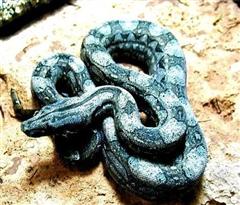Boa - Argentine
Argentine Boa Constrictor Scientific Name: Boa constrictor occidentalis
Mon, 28th April, 2025 - 12:50 pm GMT
Sponsor Ads:

Alternative Name
Argentine Boa Constrictor Scientific Name: Boa constrictor occidentalisBasic Info
The male Argentine Boa Constrictor reaches about 8 feet at maturity, and females are larger, and can grow to 10 or 12 feet! It has a gray belly with dark spots. The rest of the snake has a brownish or black background color, with a pattern of darker and lighter colors, sometimes white. The head, from the neck to the very tip of the snout, is accented with a dark line on either side. Another line runs from the eyes to the tip of the neck. A hypomelanistic variety of Argentine Boa Constrictor is also available.
Health
Their enclosure should have hot and cool places to allow your Argentine Boa Constrictor to thermoregulate, along with a hiding places. The cool end should remain around 80 degrees Fahrenheit while the warm end should be kept between 85 and 90 degrees. Make a basking spot of 90 to 95 degrees for your Boa with a strategically placed light. Cage humidity should be kept around 55 percent. Aspen shavings make a good substrate for the Argentine Boa Constrictor's enclosure, and newspaper will work as well. Breeding Argentine Boa Constrictors give birth to 10 to 40 live young in the months of June and July after a breeding period during late fall to early spring.Habitat
Most commonly found in wet forests but ranges into the grasslands and scrub forests as wellBehavior
Argentine Boa Constrictors are nocturnal, and are found both in treetops and on the ground. Argentine Boa Constrictors are extremely active and will need branches or shelves in their cages when they are kept in captivity. They have fairly docile temperaments but should be handled with caution; they may be aggressive if nervous or frightened. It has been reported that they will hiss when they are startled. Argentine Boa Constrictors need fresh water available at all times and love to soak in their water bowls.Origin
Argentina and ParaguayHistory
Native to Argentina and Paraguay, the Argentine Boa Constrictor is most commonly found in wet forests but ranges into the grasslands and scrub forests as well. They are listed as a CITES Appendix I, meaning that they must be protected because they are killed for their skins and trapped for the pet trade. Therefore, captive breeding programs are in progress and there are restrictions concerning the importation of Argentine Boas.Common Foods
In the wild, Argentine Boa Constrictors eat birds and other small animals. In captivity, they are fed rats that are occasionally dusted with a nutrient or mineral powder.Sponsor Ads:
"'T'is neither here nor there." Othello Act IV, Scene III, William Shakespeare
Boa - Argentine
Coded by: BGID® | ALL RIGHTS RESERVED Copyright © 2000-2025
Disclaimer | Privacy | Report Errors / Contact | Credits


 Why haven't we as a collective earth met with aliens yet?
Why haven't we as a collective earth met with aliens yet?  The Best Text Adventure You Will Ever Play! The official site:
The Best Text Adventure You Will Ever Play! The official site:  Homosexual behavior stems from the mind or genetics?
Homosexual behavior stems from the mind or genetics?  World EcoSystem - Biodiversity Changes - Who is on board and who isn
World EcoSystem - Biodiversity Changes - Who is on board and who isn  Mouthwash - Mouthrinse - Mouth Sores - Healing Infections - Gingivitis
Mouthwash - Mouthrinse - Mouth Sores - Healing Infections - Gingivitis  Treatment for Depression
Treatment for Depression  Ultra radical and violent Islamist group that even rivals Al Qaeda
Ultra radical and violent Islamist group that even rivals Al Qaeda  An idea to have teachers who want to carry guns to school undergo some level of police training will be left up to local school districts and police departments.
An idea to have teachers who want to carry guns to school undergo some level of police training will be left up to local school districts and police departments.